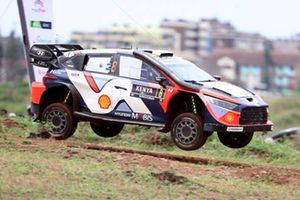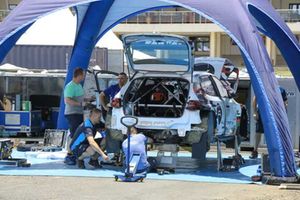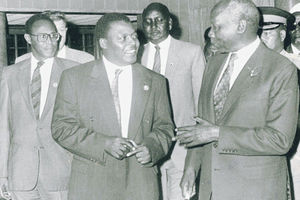
Kenyan race rally driver Jennifer Malik pictured on February 19, 2025 at The Waterfront Karen, Nairobi.
Four years ago, Jennifer Malik's life was normal, ordinary. She was a wife, a mother and a homemaker. And then her husband introduced her to racing, and her life was never the same again.
Nothing in her appearance shows this shift when we meet at Mad Max at The Waterfront in Nairobi's Karen. She comes in first, and a couple of minutes later, her husband drives in with her race car. She is from Kakamega, a little town with football fields and bullfighting arenas but no racetrack. Her journey to being a trailblazer in the racetracks in East Africa is a story of what passion and grit can do to a determined soul.
“I am a car girl, a rally girl, a tarmac racer, a mom, a wife, a sister, everything,” she says.
She started racing four years ago when her husband, who loves fast cars, bought her one and pushed her into motorsports. Her current one is her fifth of upgrades, all Subaru. It comes with the black and white of a regular racetrack car with splashes of pink visibly layered on the edges of her rims and body, and in what is traditionally considered a man's sport, Jennifer brings the dainty touch of feminine.
“I feel like they (Subarus) are nice, they are fast and stable and their handling is efficient,” she says.
For racing, she acknowledges that one ought to have an understanding of the functionalities of a car at least at a basic level.
“You must have a bit of knowledge about cars, it doesn’t have to be the deep mechanical aspects, but the basics, for me it helps whenever I am doing my rallies. One ought to know what is wrong with their car during the race, which helps with post-race diagnostics with the mechanics. Having a basic knowledge about what one is driving is also usually very crucial and critical.”
As a woman, her entry into rally racing was not met with applause across all quarters.
“It was a bit challenging getting in, I got a lot of eyes here and there, but so far the men in the industry have been supportive of me, plus I am kicking them in the track. It is a very good feeling when it is a woman doing the beating because normally, it's men who dominate the sport. Now we are here, in one of the races, amongst 65 of us who competed, I came third. I was very impressed with myself,” she tells Lifestyle.
Standard preparation for a race is determined by the type of race that she is about to get into.
“I would break it down into two. The first is rallies, which are the more complex part of racing. With rallies, you must have a team, which has a manager, mechanics and people who are going to be with you because it is a complex event that roughly takes 10 days of your time, and for that, you need a team. Tarmac racing however doesn’t take much, you just make sure your car is good, you fuel it and you are good to go,” she says.
She describes motorsport as one of the most expensive hobbies.
“Motorsport is the most expensive that there is out here, forget even golf, maybe Polo could give it a run,” she says.
How expensive?
“I will give you a hint, the block that I have here for my engine, just the block, is worth the price of buying another new car. I got mine from America,” she says.
Most race cars are not bought ready to race, most of the time, they get modified to suit the preference of the driver and Jennifer's car is no different.
“We have German cars that come in as stock and can be driven immediately and are quite fast. When you have a manual Subaru, you have to do a bit of modification to it to get to the speed that you want it to have to perform efficiently. I have had to put in bigger injectors, a bigger turbo, and an IAG engine and we are running meth, not normal fuel, I use Avgas. The car is also tuned, therefore, it gives good power, hence you can enjoy your racing,” she says.
Racing carries a risk factor for which Jennifer seems nonplussed. She worries more about the cost of repairs.
“Racing is expensive and it makes you broke, so you always want to be on the safe side to avoid further costs. Normally, we race in safe tracks on places that have been looked up and modified to be race-ready. We rarely have incidents where we are likely to get injured, but I once hit a tree so badly, people were really scared, but I only got slight bruises. I have never had any other accident since,” she says.
Jennifer is currently learning the art of drifting.
“Gymkhana is normally not good with the cars because you have to downshift most of the time. You are always in high gears and high speeds, and then you have to downshift when taking the corners, which I find a little challenging. For drag racing, it's easy, it is pedal to metal and go. For drifting, it is more like gymkhana, but you take your corners on a slide, the slide movement is what makes drifting even more fun. It is something that I am currently working on at the moment,” she says.
Jennifer acknowledges that racing has always been in her, what she needed was a nudge to get into it.
“I am glad I got married to someone who also loves cars but is too busy to race, and so I am here to do it and he is fully supportive. Even though he taught me racing, I am way faster than him now. He was my teacher, he got me my first car, but in a race, I would still destroy him,” she says laughing.
Jennifer does not struggle with life-work balance despite the perception of having her hands full.
“You must have a balance, but it is not as hard because driving is just driving. The only time I need to carry my kids with me is when I am in the World Rally Championship because I am away for longer periods and thus have to take them there with me, but the rest are just a day’s event. When I am driving, I am Jennifer Malik who drives, when I am at home, I am Mommy, and with my husband, I am his wife, there isn’t much change.”
She finds no difficulty being a woman in a male-dominated sport.
“If you are a lady and you are driving, especially a manual car, and you are good at it and winning, there is no better feeling. My driving has evolved to the extent that I am racing and winning against men. I am proud of that,” she says.
For women looking to join the sport, she has a few pointers.
“Learn cars, you need to know and understand cars, the fast cars, the cars you can use on a daily basis, what modes you can put on cars and what makes the car faster. Have the basic aspect of knowing what makes motorsport people thrive. Once you have that you can identify a car you like, and start building it slowly then start racing.”
What makes a good race driver?
“Persistence, consistency and not giving up. I am not the best, but I think I am getting better.”
Jennifer owns a couple of cars – a Dodge, a Nissan Patrol and a couple of other makes. She offers to take me for a spin at the track, which I agree to. The inside of her car carries the hallmark of a petrolhead - the dashboard looks like a small cockpit. Her driving is reckless to the untrained eye, but to a race driver, she drives expertly. The first lap leaves me jittery.
“That was just a warm-up,” she says, “I think I will pass,” I say, quickly getting out of the car.








